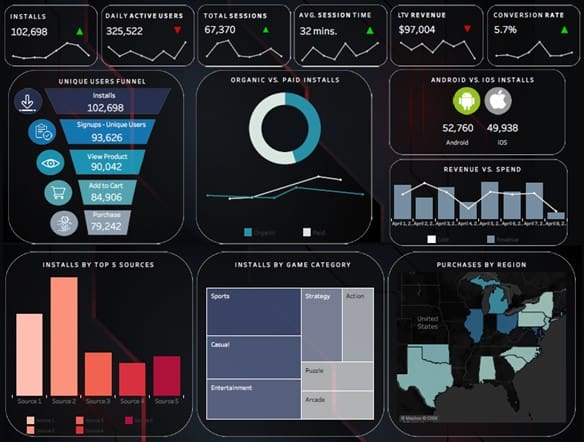Table Of Content
- Super Sample Superstore Dashboard
- Sales Pipeline Dashboard
- Create a dashboard, and add or replace sheets
- Designing for Performance
- Marketing Automation (MarTech): Strategy, Tools & Implementation
- Points to remember while designing insightful and impactful Tableau Dashboards:
- Step 6: Build a dashboard to show your insights

In worksheet five, let’s work on predicting the upcoming COVID-19 cases in the INDIAN states. Additionally, you can use a Bar Chart to represent the Recovery Rate in India. The next step will be to use the data from the “Indian States” group to generate a Map Chart that describes confirmed case count and state name details.
Super Sample Superstore Dashboard
This dashboard breaks down sales data quarterly, providing clear visibility into trends and performance. The dashboard highlights key sales metrics, trends, and performance indicators, all in one place. The dashboard displays key metrics such as purchase history, account health, and recent interactions, all in an easy-to-read format. This comprehensive dashboard brings together critical data from various touchpoints, providing a holistic view of customer interactions and account status. The sales pipeline dashboard lets you zero in on key performance indicators that matter to your business.
Sales Pipeline Dashboard
This is a powerful and simple way to make dashboards easier to navigate. In the example below, the question pulls the audience in and then tells the audience how to answer the question using the dashboard. In the second worksheet, let’s create another visualization that provides insights on the COVID-19 recovery in Indian states. With the Image object, you can either insert image files into dashboards or link to images posted on the web.
Create a dashboard, and add or replace sheets
Planning the layout of your Tableau dashboard involves sketching a rough layout, considering the size and orientation, and deciding on the elements to include. In the worksheet below, packed bubbles are used to display sales by product. It is really hard to accurately compare the sales of the different products. Spotlighting is a good example of how to emphasize what is important without overwhelming your users with color. With spotlighting only numbers that meet a defined threshold are highlighted.
Iron Viz 2022: A Behind-The-Scenes Look with Our Tableau Experts - Atrium AI
Iron Viz 2022: A Behind-The-Scenes Look with Our Tableau Experts.
Posted: Wed, 23 Mar 2022 07:00:00 GMT [source]
The best visualizations have a clear purpose and work for their intended audience. It’s important to know what you are trying to say and who you are saying it to. Does your audience know this subject matter extremely well or will it be new to them?
Designing for Performance
It’s important to make any interactivity obvious to your audience—even by creating subtitles to instruct them to click or hover for more information. Users can also interact with your visualizations by selecting marks and hovering to see tooltips. The actions you set up can respond with navigation and changes in the view.

Also, because we have the map in view, we probably don't need the South region column in Sales in the South, either. Too many views can also interfere with the performance of your dashboard after it's published. A well-designed dashboard can align your organization's efforts, help uncover key insights, and speed up decision-making. Use this topic for tips on best practices for creating effective dashboards in Tableau. This visualization tool gives visibility to the availability of products in the form of excesses or out of stock measures. In doing so, it helps you save a ton of money, since excessive products will eventually lead to spilled costs, while lack of availability indicates lost sales potential.
You can find a list of books by renowned data visualization experts in the appendix. Adding these whitepapers and books to the resources of your analytics community can lead to a deeper understanding and internalization of visual best practices. Next, let’s create a line chart that will describe the COVID-19 trend in the Indian states.
Step 6: Build a dashboard to show your insights
Building COVID-19 dashboards with Tableau at Bank of America - diginomica
Building COVID-19 dashboards with Tableau at Bank of America.
Posted: Tue, 03 Nov 2020 08:00:00 GMT [source]
This means that if you design a dashboard at 1300 x 700 pixels, Tableau will resize it for smaller displays—and sometimes this results in scrunched views or scrollbars. If you keep this setting, be sure to construct your visualization at the size which it will be viewed. You can also set Size to Automatic, so Tableau automatically adapts the overall dimensions of a visualization based on screen size. The Tableau Dashboard that you will now learn to create will include the COVID-19 data related to India. It will need multiple worksheets, and the visualizations generated, will be combined to create a Tableau Dashboard to present the viewers with detailed insights on one screen.
When building business dashboards, we will let brand colors guide us but that doesn’t mean that we’ll use the entire color palette on a dashboard. Choose one or two colors to do most of the work and then use neutral colors such as black, gray, and white where needed. To do this, you can use dashboards to display multiple worksheets at once, and—if you want—make them interact with one another. You can also display a highlighter that allows your customers to highlight parts of a view based on what they enter or select. In addition to knowing what you're trying to say, it's important to know who you're saying it to.
We’ll dive into the 15 best Tableau dashboard examples that deliver real, actionable insights. This series will cover six (6) design tips that will help you create business dashboards in Tableau that are easier to comprehend and visually more appealing. The phrase coined by Henrick Ibsen “A picture is worth a thousand words”, is a great reminder of the power of data visualizations in telling a story with data. To effectively use data to tell a story we need to make sure our dashboards support, not hinder our storytelling. Make use of filters to allow viewer interaction, add tooltips for more information, and utilize actions to link different elements together for seamless exploration of data.
The current screen shows the details related to all the states in India. Using the filter option on the right-hand side of the screen, you can get the information about a specific state or a collection of different states together. The COVID-19 IND Dashboard just created looks something like the image below. To move ahead, the forecast method can be used in analytics to generate this visualization.

No comments:
Post a Comment